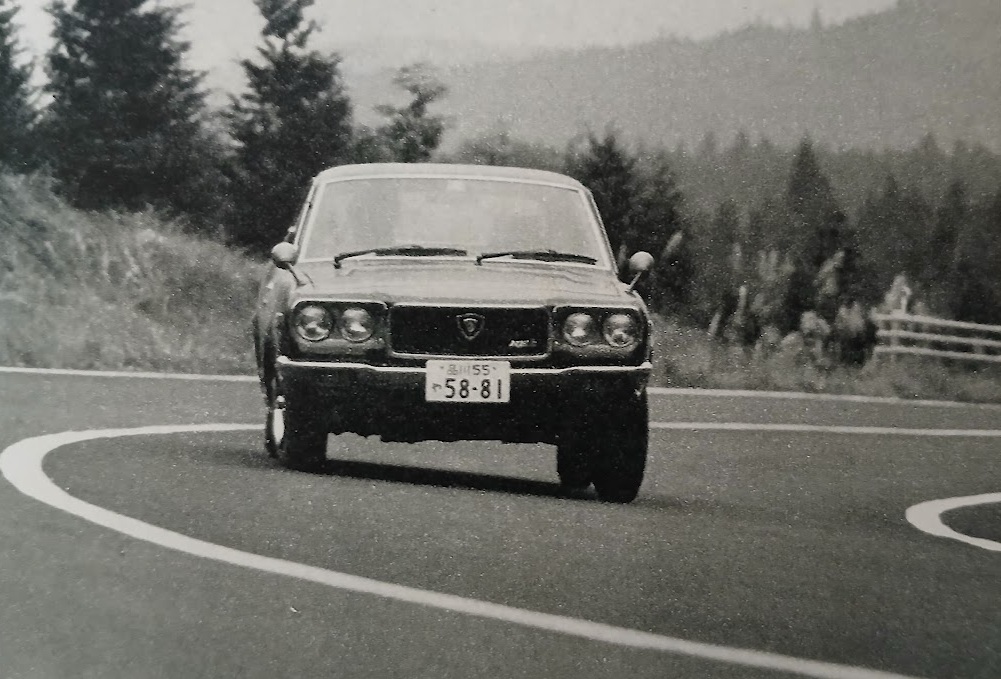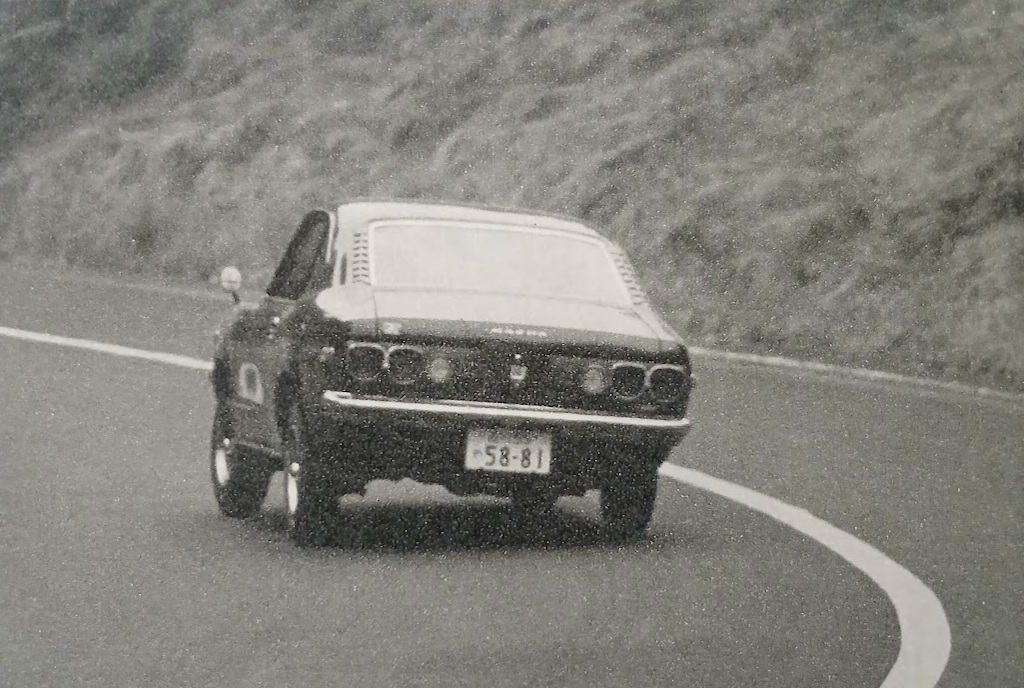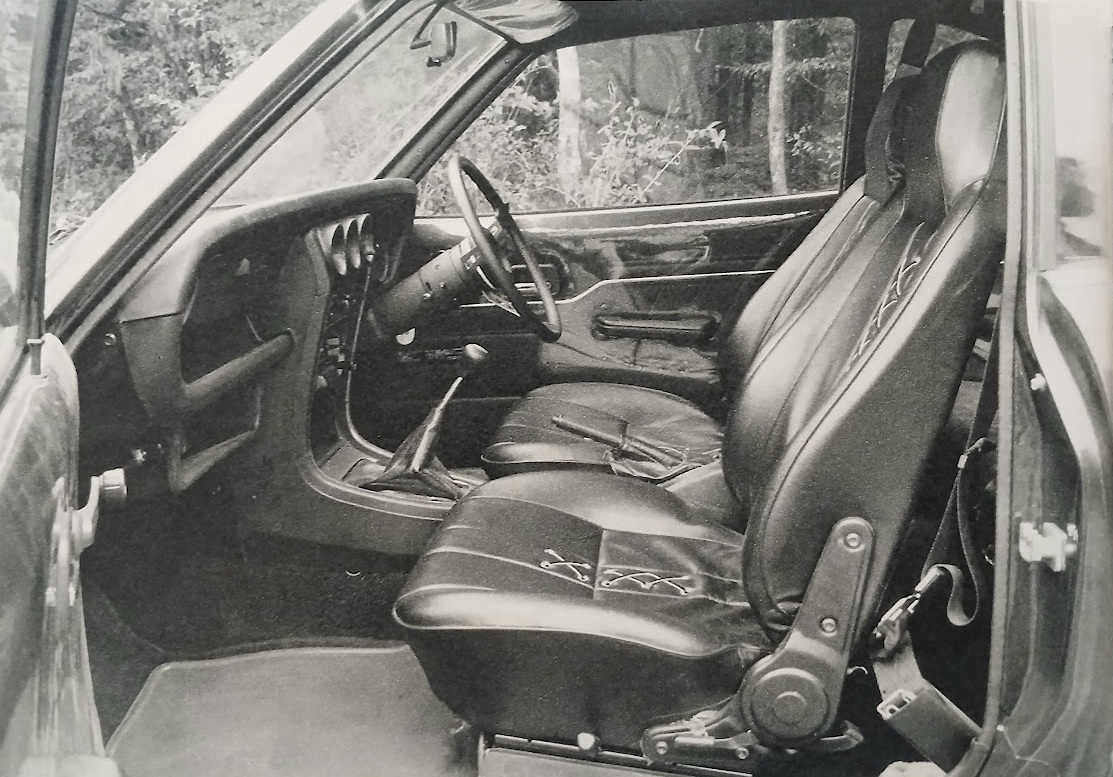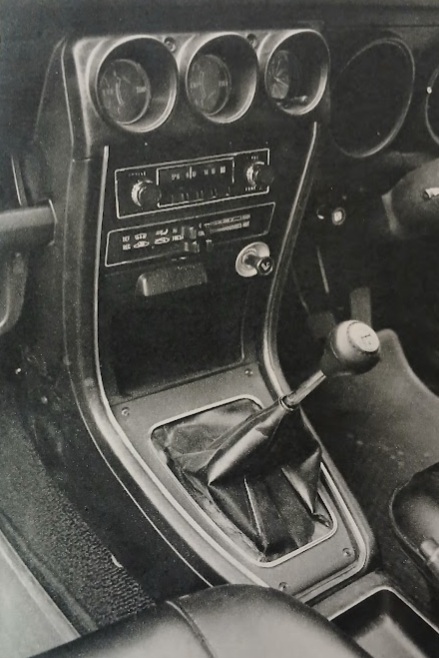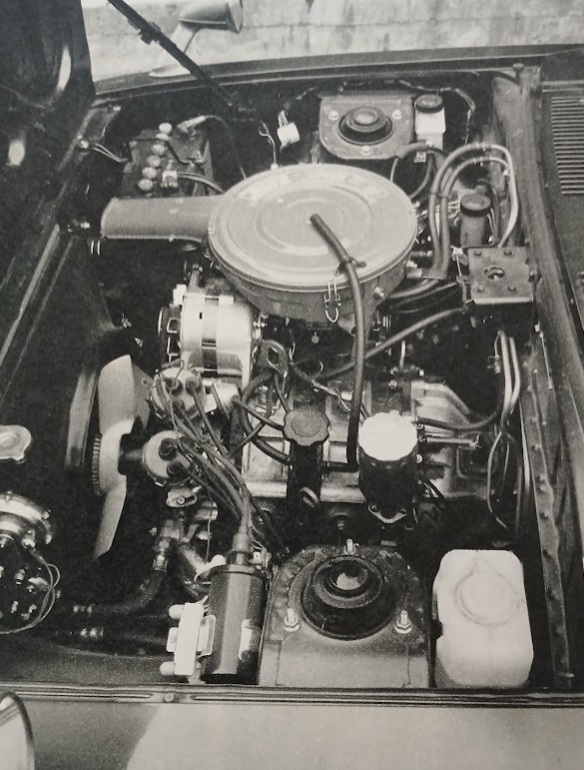Mazda Savanna GT (1972)
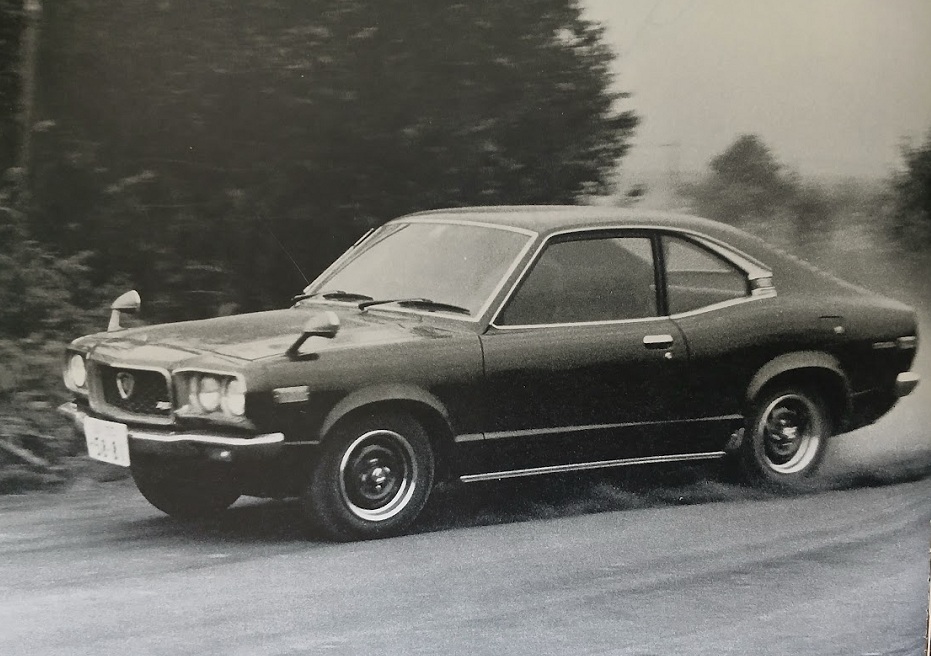
Publication: Car Graphic
Format: Road Impressions
Date: December 1972
Author: “C/G Test Group” (uncredited)
Road testing the Savanna GT
Mazda rotary cars are more highly regarded overseas than in Japan, especially in the United States, and their export numbers are growing dramatically (recently exceeding 10,000 units per month for all models). The Savanna is called the RX-3 in overseas markets, and the US market version differs from the domestic model in that it is equipped with the 12A, 573cc x 2 rotary engine used in the Capella instead of the 10A, 491cc x 2 engine that is standard here. The coupe released under the name Savanna GT as the range-topping model in the Savanna series is also equipped with the 12A engine, and can be considered the domestic version of the export RX-3. Or, racing fans may find it easier to understand it as a production version of the works Savanna (573cc x 2, naturally) that always puts up thrilling, closely-fought battles in domestic touring car races, finally shaking the legendary GT-R off its pedestal.
The main differences between the Savanna GT and the existing Coupe GS II are as follows. First, the engine was changed from a 10A type, 491cc x 2 with an output of 105ps/7000rpm to the 12A type, 573cc x 2, with 120ps/6500rpm. Second, the gearbox was changed from a 4-speed to a 5-speed type shared with the Capella GS II. Third, the suspension was stiffened and the vehicle height was lowered by 15mm (in terms of spring constants, the front was increased from 2.0kg/mm to 2.5kg/mm, and the rear from 1.65kg/mm to 2.0kg/mm), while low-profile cross-ply tires developed specifically for the GS II, in size Z78-13-4PR, are fitted as standard equipment.
The exterior changes are very minor, with RE12 emblems on the front and rear indicating the 12A engine, a “GT” trim plate on the rear quarter, and “5-speed” badging on the rear. Three new paint colors have been added, bringing the total to four. The test car was a dark gray close to black called Beat Black Metallic, which is a color particularly prone to attracting dust due to static electricity. The price is 795,000 yen, 45,000 yen higher than the 4-speed GS II.
The interior has received a minor update, and the ventilation holes in the center of the driver’s seat cushion and backrest are a nice touch. The three gauges in the center of the dash (from right to left, clock, fuel gauge, and water temperature gauge) have been redesigned from the previous square type to larger, circular gauges that are easier to read, and below them in the console are the stereo with auto-seeking radio and the heater/ventilator controls. The heater/ventilator controls are conveniently illuminated at night, but are brighter than the rest of the instrument panel and tend to intrude on the driver’s night vision.
People who buy a car like the Savanna GT will probably be most concerned with power performance and handling, so we will focus on this point in comparison with the Savanna GS II. We tested the GS II in C/G issue No. 125 and mentioned that it is much easier to handle than the previous Familia Rotary Coupe and Capella, and that the engine has improved flexibility especially at medium and low speeds, making it easier to drive. However, C/G later purchased a Savanna Sports Wagon as a long-term test car, and having already driven it over 20,000km, we are very dissatisfied that it lacks the punch that is characteristic of rotary engines. Of course, it is true that the wagon’s output is 5ps lower than the GS II’s and the weight is slightly heavier, but even taking that into account, it lacks vitality overall. Furthermore, when we tested the Capella Rotary GS II with a 5-speed gearbox in C/G issue No. 133, the top speed was only 181.8km/h, which was not as high as the 187.5km/h recorded by C/G’s own long-term test Capella GS (a very early 4-speed model). From this experience, we thought that the most recent Mazda rotary engines, for one thing, place more importance on ease of use at low and medium speeds than high-speed performance, and that secondly, due to exhaust control measures, we could no longer expect the same outstanding performance as in the past.
However, when we drove the Savanna GT, we were able to experience the thrilling acceleration that is characteristic of a rotary engine for the first time in a long time. The rev counter hits the yellow zone from 6500-7000rpm, but it is powerful and quiet across the entire rpm range, so much so that when climbing hills at high speed or overtaking, you can accidentally over-rev in second or third gear. (Note that the owner’s manual states that revving the engine above 7000rpm will void the car’s warranty). We didn’t run measured acceleration tests this time, so you’ll have to trust our judgment, but the difference in torque, which has increased from 13.7kgm to 16.0kgm, is clearly noticeable at high speeds. According to the manufacturer’s published figures, the top speed is 10km/h higher than the GS II, at 190km/h, and the 0-400m acceleration time (with two people on board) is an unbelievably fast 15.6 seconds.
Along with the increased power, it is also clear that the improved performance is the effect of the 5-speed gearbox with its closer indirect ratios. Comparing the GS II 4-speed and GT 5-speed gear ratios, the final drive remains the same at 3.70, and the tires of both are Z78-13-4PR, the 4-speed’s ratios are 3.737 / 2.202 / 1.435 / 1.000, while those of the 5-speed are 3.683 / 2.263 / 1.397 / 1.000 / 0.862. On the road, this means that when revved up to 6500rpm, the GS II reaches 49, 83, and 127km/h in first, second, and third gears, respectively, while the GT reaches 50, 82, 132, and 185km/h in first, second, third, and fourth gears, respectively. The GS II’s catalog top speed is 180km/h (about 6400rpm), but the GT can reach over 185km/h at 6500rpm even in direct fourth gear, and in overdrive fifth, it can reach 190km/h at a relatively low engine speed of 5800rpm.
These are merely calculated values, but based on our experience with past measurements using long-term C/G test vehicles, we believe that the Savanna GT will easily reach a top speed of 190km/h. When it comes to actual measurements taken at Yatabe with long-term C/G test vehicles, the Familia Rotary Coupe, with a power-to-weight ratio of 8.15kg/ps, reached 184.0km/h, and the Capella Rotary Coupe GS, with a power-to-weight ratio of 8.00kg/ps, reached 187.5km/h. Therefore, since the Savanna GT has a better power-to-weight ratio than either of these two cars, at 7.37kg/ps, we would not be surprised if it reached 190km/h in instrumented testing.
The extra margin of power is clearly felt in any situation. In normal driving, the Savanna’s throttle response is so gratifyingly quick that you tend to rev it up whether you need to or not, but in 60km/h zones in the city, you can stay ahead of the flow of traffic without using more than 3000rpm, and even use fourth gear. Overdrive fifth is fully usable above 60km/h. Therefore, on the Tomei Expressway, we always used fifth gear, and only occasionally used fourth when passing cars on uphill stretches. At speeds below 100km/h, you can imagine how low the overall noise level is when you shift from fourth to fifth gear and hear the light transmission hum more than the reduced engine noise. At 115km/h on the unusually accurate speedometer (at an indicated 110km/h, the actual speed is 99.5), a light overspeed warning starts to sound, which is the biggest source of noise at this speed.
Mazda rotary gearboxes generally have weak synchros, and the Savanna GT’s was no exception. It was impossible to shift quickly without crunching through first, second, and third gears. Fifth gear, at the upper right of the H-pattern, is selected by pushing against a strong spring, and although there is no risk of making a mistake, the lever stroke is quite large. Also, right after a cold start, shifting through the low gears was extremely heavy until the transmission oil warmed up after driving a few kilometers.
It was expected that the 5-speed gearbox would have a positive effect on fuel economy, which is a common drawback of rotary engine vehicles. However, in this test, the total average fuel economy over a 420km drive from the Tomei Expressway to the Fuji Five Lakes area and the Chuo Expressway, with fifth gear being used frequently, was a disappointing 6.84km/l. For comparison, the observed fuel economy of the Savanna GS II with a 491cc x 2 105ps engine and 4-speed gearbox, with roughly the same driving pattern, was 7.46km/l, while the Capella GS II with a 5-speed gearbox achieved 6.71km/l.
The Savanna GT’s ride is hard by any standard. Or rather, it should be said that it is excessively hard, and even on paved roads, there are constant sharp, short up-and-down motions. As the speed increases, the ride becomes flatter even on the same road surface, but when driving on the Tomei Expressway at 100km/h, if you go over a drainage ditch crossing the road, you will still be jolted up and down sharply. The specified tire pressure for high-speed driving is 1.8/1.8kg. On the other hand, the ride on relatively uniform dirt is as good as that of a standard rally car, and you can easily maintain a speed of 70 to 80km/h. In other words, its reactions to single bumps are exaggerated, but it can ride over regular, consecutive imperfections at a high speed. In any case, as far as ride comfort is concerned, it is at the same level as the old rough-riding Fairlady 2000 and Bellett GTR, and it will most certainly tire you out after a half-day’s worth of driving.
Comparing the handling to the Savanna GS II, it can only be said that it has been slightly improved in the GT, but at the expense of a great deal of comfort and chassis composure. It is true that body roll in the corners has decreased and that maximum cornering speed has increased accordingly, but along the way, it has become more difficult to trace a clean line through the corners.
Let us explain this point with the example of one particular uphill corner that can be taken at 80 to 90km/h, which we often use for cornering tests. The tires are Bridgestone Skyway Deluxe Z78-13-4PR, the tire pressure is 1.8/1.8kg, and the variable ratio steering still has a small amount of free play around the straight-ahead position. Because of this, you need to turn the wheel quite hard at first, and there is a slight phase lag before the steering actually starts to respond, but the cornering power of the Z78 tires is exceptionally high for bias-plies, and the understeer is mild, which suits the preferences of fast drivers. Almost at the same time that the steering really bites into the turn, the chassis takes a set and the mild body roll does not increase any further, and you can return some of the steering angle you had dialed in. Immediately after this, the car’s acceleration reaches its peak, but the understeer becomes stronger and you have to turn the wheel inward again. However, the power at 4000rpm (about 80km/h) in third gear is fierce enough that the inside rear wheel reaches the limits of grip, causing it to spin, and ultimately turning into oversteer. Therefore, you have to quickly return the steering wheel again.
This description may make it sound like a gradual process, but it actually happens within just a few seconds, so it requires very delicate throttle work and steering. If the timing of the two inputs is not right, the line will become a discontinuous curve. In other words, if you drive the GT well, it will be faster than the GS II, but since the limit characteristics are more delicate, it is more difficult to control. Despite the wide tires, the steering force is still not heavy, even at low speeds.
In conclusion, the Savanna GT is not a practical GT suitable for long-distance and high-speed travel, but is closer to a sports car purely for the enjoyment of driving. It is a good choice for those who are skilled, but for the average driver, the GS II, which is much more comfortable to drive, is already more than sufficient.
Postscript: Story Photos
